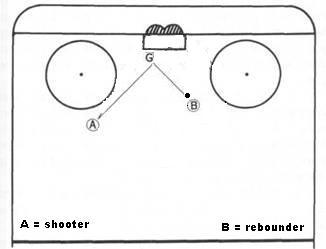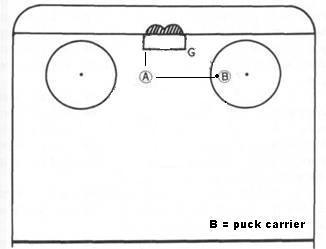

If there’s one area where NHL 2K10 significantly outperforms NHL 10, it’s in the variety-of-goals department. NHL 10, while fun to play, really limits the ways you’re able to generate goals. So hockey fans who pick up the game and try to replicate the kinds of scoring strategies they see on TV might have issues earning wins at first.
Fact is, if players wants to score consistently in NHL 10, they have to drop some of those real-life strategies (scoring off clean shots) and lean a bit more on the side of “video-game strategy.”
So with that in mind, here are some ways to consistently score in NHL 10.
For beginning players, the easiest way light the lamp in NHL 10 is by putting the puck on net and having a teammate swoop in to clean up the rebound while the goalie is still recovering from the first save. Pulling off a successful rebound goal comes down to two factors:
The shooter will always want to aim low and away to generate a rebound that bounces towards the middle of the ice; however, knowing when to unleash the shot can be just as important as knowing where to place it.

Ideally, you want to shoot the puck a stride or two after your teammate crosses the blue line. This way he will be hitting the crease right as the puck comes off the goalie’s pads. Once you get the timing down, the rebound becomes one of the easiest ways to create scoring chances in NHL 10.
For whatever reason, the default "screen effect" in NHL 10 is significantly lower than what it was last year, so screen goals are much less prevalent overall than they were in NHL 09. To compensate, NHL 10 adds several new animations for deflections, including some that let you "bat in" pucks that are hanging in mid-air.
Unfortunately, since all the deflection animations are randomly generated, there’s not much a player can do to generate a tipped shot besides facing the shooter (by holding the left trigger/L2) and keeping his stick in the shooting lane.

Forget about trying to screen the goalie -- deflections are NHL 10's tactic of choice in front of the net.
If you’re going for a deflection (and you should be, since screens are so hard to get now), it’s important to position yourself on the outside of the shooting lane so that the puck does not wind up hitting your player and never reaching the goal.
Dekes
Like many things in NHL 10, the effectiveness of your dekes depends largely on your player rating. Generally speaking, a player with a deke rating in the range of 80-85 should be able to fake a goalie out with one or two simple dekes. For players with lower ratings, more dekes are often necessary to get the goalie out of position and open up a shooting lane.
Obviously, most deke chances come off breakaways and penalty shots, so depending on your angle of approach, here are a few moves that will help you get the goalie out of position:
Coming in from a 45 degree angle
Coming right at the goalie
With a little practice, you should be able to pull off the more complicated penalty-shot dekes with some consistency. But to get the simplified breakaway moves to work, it’s all about two things:
Timing is something you just have to get a feel for, but as a general rule, it’s best to start your deke as you come across the hash marks.
While a high deke rating can cover up bad timing (and vice versa), if you have got both bases covered, you should be converting a pretty high percentage of your breakaway opportunities (at least half) into goals.
Since its introduction in NHL 94, the one-timer has been a high percentage scoring tactic in EA hockey games. While the removal of tape-to-tape passing makes it a bit more difficult to generate one-timer goals in NHL 10, if you can make the pass, the actual shot will go in more times than not.
Simply let your teammate bring the puck out wide, then skate along -- forming a right triangle between your teammate and the opposite post -- for an easy one-timer opportunity.

Let the puck carrier skate out beyond the near post, then evenly line yourself up with the far post for an easy one-timer.
When finishing the one-timer, try to aim your shot at one of three places:
With proper positioning, the one timer makes for a great tactic against defenses that over pursue the puck carrier during an odd-man rush; however, if teams start playing the pass and guarding against the one-timer, the puck carrier might want to think about shooting low at the goalie’s pads to generate a "bank pass" for a rebound goal.
It may not always be pretty, but with goalies still being as superhuman as ever in NHL 10, sometimes you have to think like a video game to score in a video game.
Got any other great scoring strategies that are not covered here? Feel free to share them in the comment box below.




 NL Central Team Strategy Guides
NL Central Team Strategy Guides OS Tip of the Day: Find your Rhythm (Tiger 13)
OS Tip of the Day: Find your Rhythm (Tiger 13) OS Tip of the Day: Know When to Charge the Net (Top Spin 4)
OS Tip of the Day: Know When to Charge the Net (Top Spin 4) NHL 10: Goalie Guide
NHL 10: Goalie Guide Madden NFL 12: Winning on Draft Day
Madden NFL 12: Winning on Draft Day